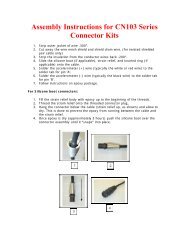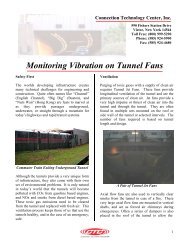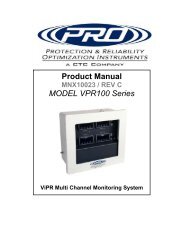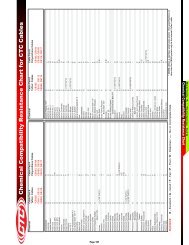Accelerometer’s for Wind Turbines
Accelerometer's for Wind Turbines - Connection Technology Center
Accelerometer's for Wind Turbines - Connection Technology Center
You also want an ePaper? Increase the reach of your titles
YUMPU automatically turns print PDFs into web optimized ePapers that Google loves.
Connection Technology Center, Inc.590 Fishers Station DriveVictor, New York 14564Toll Free: (800) 999-5290Phone: (585) 924-5900Fax: (585) 924-4680<strong>Accelerometer’s</strong> <strong>for</strong> <strong>Wind</strong> <strong>Turbines</strong>Alternative Energy<strong>Wind</strong> turbines are a growing source ofalternative clean energy sources. As individualmachines, or combined as multiple machines to<strong>for</strong>m wind farms, they are a growing presence intoday’s world and energy needs.A wind turbine that converts the wind’smechanical energy into electrical energy isknown as a wind generator. The size of windgenerators can range from 500 kW to 6 MW.The most popular styles of wind generators arehorizontal axis wind turbines. They have either3 blades, and point upwind of the towerrequiring rotational (yaw) control, or they have 2blades, and point down wind of the towernaturally rotating with the wind. Occasionallyyou find a vertical axis wind turbine, also knowas a Darrieus wind turbine, named after theFrench inventor. This “eggbeater” design is notpopular, and has been overwhelmed by theper<strong>for</strong>mance of horizontal axis wind turbines.<strong>Wind</strong> turbines have many things in commonwith low speed motor driven fans, like coolingtowers. Instead of motors driven by electricalmains, providing mechanical energy to multiplereduction gearboxes, driving large low speed fanapplications, the wind turbine is a large lowspeed fan, providing mechanical energy tomultiple speed increasing gearboxes, driving agenerator to produce electrical mains power.This process reversal has many rotating elementsthat cause vibration and over time, with wear andtear, will eventually fail.• The repairs can be very expensive• The work height prohibitive• The loss of electrical production costly.Axial SensorsRadial SensorsGeneratorHorizontal Axis Turbine with AccelerometersLow Frequency AccelerometersGearboxMain Bearing(s)The main bearing(s) and rotor shaft turn at lessthan 30 rpm. This would also be the turningspeed of the input shaft <strong>for</strong> the gearbox. With arotational frequency less than 30 cpm (0.5 Hz),low frequency accelerometers should be used.This will allow measurement of the main shaftrotational frequency, blade pass frequency, mainbearing frequencies, and gearbox input shaftbearing frequencies and gear mesh frequencies.1
These low frequency accelerometers typicallyprovide 500 mV/g and a frequency span of 12 –180,000 cpm (0.2 – 3000 Hz).increased rotation speeds <strong>for</strong> the gearbox andgenerator, a general purpose accelerometer willwork. General purpose accelerometers typicallyprovide 100 mV/g and a frequency span of 30 –900,000 cpm (0.5 – 15,000 Hz).Low Frequency AccelerometersAxial & Vertical General PurposeAccelerometers Stud Mounted on Gear BoxLow Frequency Accelerometer Mounted inHorizontal Axis on Main BearingGeneral Purpose AccelerometersThe intermediate shaft and output shaft of thegear box will have higher rotational speeds andgenerate higher frequency disturbances relativeto the bearings and gear mesh. The output of thegearbox will typically be rotating 50 – 60 timesfaster than the input shaft. As a result of theseGeneral Purpose AccelerometersStud Mounting AccelerometersThe wind turbine is sitting on the top of a veryhigh tower. The rotational components are noteasy to access, and every ef<strong>for</strong>t should be madeto stud mount the accelerometers. Mounting2
CTCVIBRATION ANALYSIS HARDWAREwww.ctconline.com








